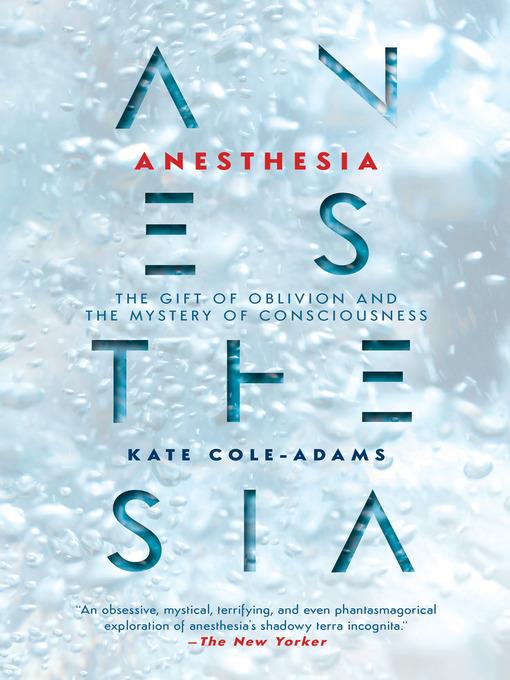
Anesthesia
The Gift of Oblivion and the Mystery of Consciousness
هدیه فراموشی و راز آگاهی
کتاب های مرتبط
- اطلاعات
- نقد و بررسی
- دیدگاه کاربران
نقد و بررسی

October 1, 2017
Melbourne-based journalist and novelist Cole-Adams (Walking to the Moon, 2008) blends research, reflection, and memoir to try to grapple with the meaning of consciousness.When someone is anesthetized for an operation, they are usually told that they will be "going to sleep." What actually happens is much more complex, and not even anesthesiologists can agree on or fully explain what happens under anesthesia. In her first work of nonfiction, the author seeks to uncover some of the ethical implications of this procedure, such as the potential impact of words by doctors when a patient is unconscious or how to deal with the small but still troubling percentage of patients who wake up in pain during surgery, unable to communicate. She depicts her interactions with some of the foremost researchers working to understand these and other questions--e.g., why patients remember things that happened under anesthesia only when hypnotized and how an anesthesiologist can actually tell if a patient is awake. While Cole-Adams has amassed a lot of useful information and telling anecdotes, her purpose is not to simply narrate a history of anesthesia or to describe with scientific detail what happens to the brain when anesthetized. Incorporating dream accounts and bits of memoir, weaving in and out of her own and others' stories, and sharing her own limitations of understanding, the author uses a collagelike structure that seems to mimic the amorphous nature of the mind as someone drifts into unconsciousness under anesthesia. As Cole-Adams writes, "part of the difficulty in talking about anesthesia--not how to do it, but what it actually does--is that any discussion veers almost immediately into the mystery of consciousness."While the author raises more questions than she answers, and some readers may be put off by her less-that-straightforward style, these are thought-provoking questions, and Cole-Adams presents a lyrical journey through the vital question of what it means to be human.
COPYRIGHT(2017) Kirkus Reviews, ALL RIGHTS RESERVED.

October 9, 2017
Australian journalist and novelist Cole-Adams (Walking to the Moon) mingles her own experiences under anesthesia with those of other patients and doctors, producing a personal work that is a mix of agony and insight. Anesthesiologists, she writes, routinely overestimate the amount of “anesthetic cocktail” needed to sedate a patient, but a strong dose still does not prevent “one or two per thousand” patients from waking up during surgery. Cole-Adams relates patients’ experiences of pain and paralysis; she also chats with psychologists as they prepare patients for surgery and, later, work with patients who have difficulty getting back to health after surgery. A medical history of anesthesia is worked through the text. Cole-Adams considers surgical-room banter and its effects on patients; she refers to a strange incident in which a patient became suicidal after surgery, revealing under hypnosis that she heard the surgeon say she was fat. The limitations of hypnosis, the complexities of memory, and the difference between the conscious and unconscious minds are questions that persist throughout this book. Cole-Adams weaves her own mounting personal problems throughout the text. Readers may react to this work similarly to the psychiatrist who told Cole-Adams, “I’m not certain whether you’re trying to sort yourself out, or whether you’re trying to sort out other things.” Agent: Jenny Darling, Jenny Darling & Associates (Aus.).

December 1, 2017
The disappearing act. That's how Cole-Adams, an Australian author fretful over forthcoming spinal surgery for scoliosis, portrays general anesthesia. A significant portion of her book explores the terrifying topic of anesthesia awareness (one or two patients in a thousand describe waking up while under anesthesia). Current anesthetic concoctions consist of three main ingredients: a hypnotic agent that induces and maintains unconsciousness, a neuromuscular paralytic compound to prevent the body from moving, and analgesics to block pain. Cole-Adams blends bits of pharmacology, neurology, philosophy, and ethics with interviews of patients, researchers, and anesthesiologists in her examination of the subject, but she is left with big, baffling questions about the nature of consciousness and memory. And what about the possibility that general anesthesia might somehow permanently change who we are? It's tantalizing (and scary) to imagine what exactly happens to us when we are chemically put to sleep. What's our mind up to while we're under; is it hibernating or unleashed? Readers may find some stretches of Anesthesia numbing, but there is sufficient science and mystery to keep them entranced.(Reprinted with permission of Booklist, copyright 2017, American Library Association.)

























دیدگاه کاربران